
Galactic Empire is a strategy video game written by Doug Carlston for the TRS-80 and released 1980. It is the first game in the Galactic Saga and became first game published by Broderbund which was, in fact, created for the purpose of publishing the game. Galactic Empire was ported to the Apple II and Atari 8-bit computers and followed by three sequels. The game was also published by Adventure International.

Time Bandit is a maze shoot 'em up written for the TRS-80 Model I by Bill Dunlevy and Harry Lafnear and published by MichTron in 1983. It was ported to the TRS-80 Color Computer and Dragon 32, but enjoyed its greatest popularity several years later as an early release for the Atari ST. It was also released for the pseudo-PC-compatible Sanyo MBC-55x with 8-color display. Amiga and MS-DOS versions were ported by Timothy Purves.
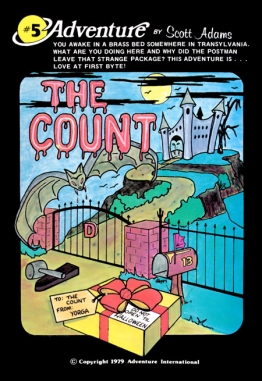
The Count is a text adventure written by Scott Adams and published by Adventure International in 1979. The player character has been sent to defeat the vampire Count Dracula by the local Transylvanian villagers, and must obtain and use items from around the vampire's castle in order to defeat him.
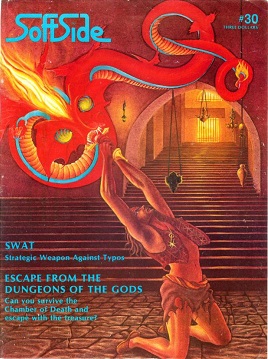
SoftSide is a defunct computer magazine, begun in October 1978 by Roger Robitaille and published by SoftSide Publications of Milford, New Hampshire.

Escape from the Dungeons of the Gods is a single-player text adventure written by Ray Sato for the TRS-80. The original and versions for the Atari 8-bit computers and Apple II were published in the August 1982 issue of SoftSide. It was subsequently republished in The Best of SoftSide (1983) and released on accompanying 5¼-inch floppy disks.

Operation Sabotage is a text adventure game by Ray Sato for the TRS-80 and published by SoftSide Magazine in 1982. It was ported by Rich Bouchard to the Atari 8-bit computers and translated for Apple II by Ron Shaker and later the IBM Personal Computer by Fred Condo & Kerry Shetline. The game was republished in The Best of SoftSide (1983), which also included the program on an accompanying 5¼-inch floppy disk.
Adventure International was an American video game publishing company that existed from 1979 until 1986. It was started by Scott and Alexis Adams. Their games were notable for being the first implementation of the adventure genre to run on a microcomputer system. The adventure game concept originally came from Colossal Cave Adventure which ran strictly on large mainframe systems at the time.
Russ Wetmore is an American programmer and video game designer best known for writing commercial games and applications for Atari 8-bit computers in the early to mid 1980s. His Frogger-inspired Preppie! was published by Adventure International and praised by reviewers for the music and visuals. He also wrote the maze-game sequel, Preppie! II. Wetmore stopped writing games after the video game crash of 1983 and developed the integrated HomePak productivity suite for Batteries Included. He has remained in software development in director and architecture roles.

Empire of the Over-Mind is an interactive fiction game written by Gary Bedrosian and published by Avalon Hill for the Apple II, Atari 8-bit computers, and TRS-80 in 1981. A version with an enhanced display for IBM PC compatibles by Bedrosian was published in 1986.

Stone of Sisyphus is a 1981 video game developed by Chameleon Software for the Apple II, Atari 8-bit family, and TRS-80, and published by Adventure International.
Med Systems Software was a company that produced video games for home computers in the early 1980s. In 1983, the company name was changed to Screenplay.

The Eliminator is a horizontally scrolling shooter video game written by Terry Gilman and Wayne Westmoreland for the TRS-80 and published by Adventure International in 1981. It was ported to the Atari 8-bit computers and Apple II. The Eliminator is a clone of the Defender arcade game.
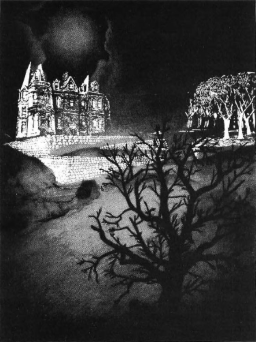
Windsloe Mansion is a text adventure published by Adventure of the Month Club for the Apple II, Atari 8-bit computers, and TRS-80. It was the January 1982 Adventure of the Month.
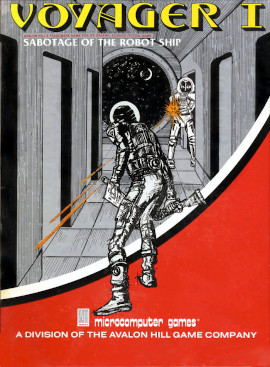
Voyager I: Sabotage of the Robot Ship is a computer game designed and programmed by William D. Volk, and published by the Microcomputer Games division of Avalon Hill. It was originally released for the Apple II in 1981, with later versions for the Atari 8-bit computers, TRS-80 Color Computer, TRS-80, and Commodore PET.

Lunar Lander is a 1980 video game published by Adventure International.

Protector II is a video game written by Mike Potter for Atari 8-bit computers and published by Synapse Software in 1982. It is a sequel to 1981's Protector; both games are horizontally scrolling shooters inspired by the arcade video game Defender. Protector II was ported to the Commodore 64, TI-99/4A, and TRS-80 Color Computer.
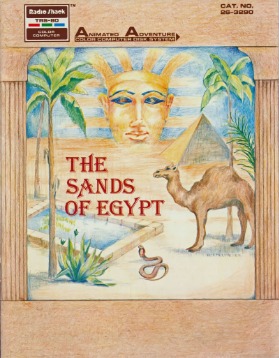
The Sands of Egypt is a 1982 graphic adventure game written by James Garon, Ralph Burris, and Steve Bjork of Datasoft for the TRS-80 Color Computer. It was licensed to Tandy Corporation and was the first disk-only game for the Color Computer sold by RadioShack. Ports to Atari 8-bit computers in 1982 and Apple II in 1983 were published by Datasoft. Set in 1893, the game follows a British explorer and archaeologist who is lost in the desert. Text commands are entered in the lower half of the screen, while a sometimes animated image of the current location is displayed in the upper half.

Clowns and Balloons is a circus-themed video game written by Frank Cohen for Atari 8-bit computers and published in 1982 by Datasoft. The game was also released for the TRS-80 Color Computer, written by Steve Bjork who had released a similar game called Space Ball for the TRS-80 in 1980. Clowns and Balloons is a clone of the 1977 arcade game Circus. A variant of Breakout, the player moves a trampoline left and right to catch a bouncing clown who pops rows of balloons at the top of the screen with his head.















